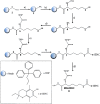Solid phase synthesis of mitochondrial triphenylphosphonium-vitamin E metabolite using a lysine linker for reversal of oxidative stress
- PMID: 23341934
- PMCID: PMC3544826
- DOI: 10.1371/journal.pone.0053272
Solid phase synthesis of mitochondrial triphenylphosphonium-vitamin E metabolite using a lysine linker for reversal of oxidative stress
Abstract
Mitochondrial targeting of antioxidants has been an area of interest due to the mitochondria's role in producing and metabolizing reactive oxygen species. Antioxidants, especially vitamin E (α-tocopherol), have been conjugated to lipophilic cations to increase their mitochondrial targeting. Synthetic vitamin E analogues have also been produced as an alternative to α-tocopherol. In this paper, we investigated the mitochondrial targeting of a vitamin E metabolite, 2,5,7,8-tetramethyl-2-(2'-carboxyethyl)-6-hydroxychroman (α-CEHC), which is similar in structure to vitamin E analogues. We report a fast and efficient method to conjugate the water-soluble metabolite, α-CEHC, to triphenylphosphonium cation via a lysine linker using solid phase synthesis. The efficacy of the final product (MitoCEHC) to lower oxidative stress was tested in bovine aortic endothelial cells. In addition the ability of MitoCEHC to target the mitochondria was examined in type 2 diabetes db/db mice. The results showed mitochondrial accumulation in vivo and oxidative stress decrease in vitro.
Conflict of interest statement
Figures



Similar articles
-
Synthesis and analysis of conjugates of the major vitamin E metabolite, alpha-CEHC.Free Radic Biol Med. 2002 Sep 15;33(6):807-17. doi: 10.1016/s0891-5849(02)00974-7. Free Radic Biol Med. 2002. PMID: 12208368
-
First synthesis of rac-(5-2H3)-alpha-CEHC, a labeled analogue of a major vitamin E metabolite.J Org Chem. 2004 Dec 24;69(26):9303-6. doi: 10.1021/jo048514u. J Org Chem. 2004. PMID: 15609972
-
Novel urinary metabolite of alpha-tocopherol, 2,5,7,8-tetramethyl-2(2'-carboxyethyl)-6-hydroxychroman, as an indicator of an adequate vitamin E supply?Am J Clin Nutr. 1995 Dec;62(6 Suppl):1527S-1534S. doi: 10.1093/ajcn/62.6.1527S. Am J Clin Nutr. 1995. PMID: 7495255
-
Triphenylphosphonium (TPP)-Based Antioxidants: A New Perspective on Antioxidant Design.ChemMedChem. 2020 Mar 5;15(5):404-410. doi: 10.1002/cmdc.201900695. Epub 2020 Feb 11. ChemMedChem. 2020. PMID: 32020724 Review.
-
gamma-tocopherol, the major form of vitamin E in the US diet, deserves more attention.Am J Clin Nutr. 2001 Dec;74(6):714-22. doi: 10.1093/ajcn/74.6.714. Am J Clin Nutr. 2001. PMID: 11722951 Review.
Cited by
-
Mitochondria-Targeted Triphenylphosphonium-Based Compounds: Syntheses, Mechanisms of Action, and Therapeutic and Diagnostic Applications.Chem Rev. 2017 Aug 9;117(15):10043-10120. doi: 10.1021/acs.chemrev.7b00042. Epub 2017 Jun 27. Chem Rev. 2017. PMID: 28654243 Free PMC article. Review.
-
Triphenylphosphonium and D-α-tocopheryl polyethylene glycol 1000 succinate-modified, tanshinone IIA-loaded lipid-polymeric nanocarriers for the targeted therapy of myocardial infarction.Int J Nanomedicine. 2018 Jul 10;13:4045-4057. doi: 10.2147/IJN.S165590. eCollection 2018. Int J Nanomedicine. 2018. PMID: 30022826 Free PMC article.
References
-
- Kuroki T, Isshiki K, King GL (2003) Oxidative stress: the lead or supporting actor in the pathogenesis of diabetic complications. J Am Soc Nephrol 14: S216–220. - PubMed
-
- Brownlee M (2005) The pathobiology of diabetic complications: a unifying mechanism. Diabetes 54: 1615–1625. - PubMed
-
- Brennan JP, Southworth R, Medina RA, Davidson SM, Duchen MR, et al. (2006) Mitochondrial uncoupling, with low concentration FCCP, induces ROS-dependent cardioprotection independent of KATP channel activation. J Cardiovas Res 72: 313–321. - PubMed
-
- Tsutsui H, Kinugawa S, Matsushima S (2011) Oxidative stress and heart failure. Am J Physiol 301: H2181–2190. - PubMed
Publication types
MeSH terms
Substances
Grants and funding
LinkOut - more resources
Full Text Sources
Other Literature Sources
Medical
Miscellaneous

